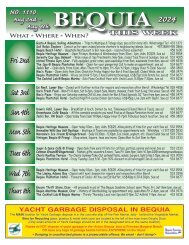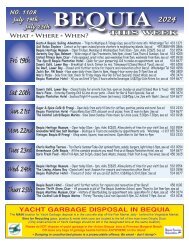Caribbean Compass Yachting Magazine - December 2021
Welcome to Caribbean Compass, the most widely-read boating publication in the Caribbean! THE MOST NEWS YOU CAN USE - feature articles on cruising destinations, regattas, environment, events...
Welcome to Caribbean Compass, the most widely-read boating publication in the Caribbean! THE MOST NEWS YOU CAN USE - feature articles on cruising destinations, regattas, environment, events...
Create successful ePaper yourself
Turn your PDF publications into a flip-book with our unique Google optimized e-Paper software.
DECEMBER <strong>2021</strong> CARIBBEAN COMPASS PAGE 26<br />
THE CARIBBEAN SKY: FREE SHOW NIGHTLY!<br />
The Sky from Mid-<strong>December</strong> to Mid-January<br />
by Jim Ulik<br />
The launch of the James Webb Space Telescope is scheduled for <strong>December</strong> 18th<br />
from Kourou, French Guiana. Of course, it is dependent upon a good weather<br />
window. If the launch window opens at night there may be a chance for those with<br />
a clear view of the horizon from east Trinidad or Tobago to spot the rocket leaving<br />
Earth’s atmosphere. It might be possible to see the Ariane 5 rocket plume or exhaust<br />
up to 600 nautical miles away when it reaches 60 miles above Earth. Added to the<br />
visual distance is the viewing height of the observer. A person six feet tall would add<br />
another 2.87 nautical miles. The formula used to calculate the visual distance is the<br />
square root of height X 1.17 = distance to the horizon in nautical miles.<br />
This is all an exercise in viewing possibilities. One variable, the rocket is launched<br />
in the direction of Earth’s rotation and orbit around the Sun. A rocket launched near<br />
the equator will get an initial boost of 1,675 kilometers per hour (1,041 miles per<br />
hour) equal to the velocity of Earth surface. While the rocket arcs eastward any<br />
location on Earth also rotates in the same<br />
direction allowing some potential to keep an<br />
eye on the rocket.<br />
Thursday, <strong>December</strong> 16th<br />
Mars is rising early this morning just out of<br />
reach from the claws of Scorpius. In the<br />
predawn sky there may be a shooting star or<br />
two from the Comae Berenicid meteor shower.<br />
This shower peaked overnight and may<br />
produce its best displays shortly before dawn.<br />
The Comae Berenicid shower will be active<br />
<strong>December</strong> 12th to 23rd.<br />
Comet C/<strong>2021</strong> Leonard may become visible<br />
in the western sky shortly after sunset this<br />
evening. Even though it is potentially bright<br />
enough to be seen with the naked eye, a pair<br />
of binoculars may be required to spot the<br />
comet. The comet is located between Mercury<br />
and Venus. Over the next few days it will<br />
become less bright as it shifts left of Saturn.<br />
See Image 3. The incoming comet was<br />
discovered in January <strong>2021</strong>. It reached its<br />
closest point to Earth on <strong>December</strong> 12 but not<br />
visible because it was lost in the glare of the<br />
Sun. The comet is destined to make its closest<br />
approach to the Sun on January 3rd, 2022.<br />
Saturday, <strong>December</strong> 18th –<br />
Sunday, <strong>December</strong> 19th<br />
The Moon will transition into its full phase<br />
just after midnight. The Moon is 180 degrees<br />
away from the Sun’s ecliptic longitude, as<br />
observed from the center of the Earth.<br />
Taurus, Orion and Gemini will carry the<br />
Moon across the night sky until sunrise.<br />
Monday, <strong>December</strong> 20th<br />
The <strong>December</strong> Leonis Minorid meteor<br />
shower is active from <strong>December</strong> 5th through<br />
February 4th. This shower may peak tonight,<br />
but the best dates to spot any meteors will be<br />
before <strong>December</strong> 14th or after January 1st<br />
when there is no interference from moonlight.<br />
Meteors will radiate out of an area between<br />
Leo and Leo Minor.<br />
IMAGE 2 ESA - D. DUCROS<br />
Tuesday, <strong>December</strong> 21st<br />
Today is the darkest day of the year in the Northern Hemisphere. The Sun is<br />
directly over the Tropic of Capricorn in the Southern Hemisphere. Like it or not,<br />
today is the winter or <strong>December</strong> solstice.<br />
There is a conjunction between the Moon and Pollux tonight. The pair can be seen<br />
in the eastern sky around 2200 hours. The yellow orange star is located below or<br />
east of the Moon. Pollux is almost nine times the diameter of the Sun and about 30<br />
times the Sun’s brightness in visible light. The planet orbiting Pollux has over two<br />
times the mass of Jupiter.<br />
Thursday, <strong>December</strong> 23rd<br />
The Ursids meteor shower produces shooting stars from <strong>December</strong> 17th to<br />
<strong>December</strong> 26th.<br />
—Continued on next page<br />
James Webb Space Telescope leaving Earth for its 1.5 million kilometer<br />
(1 million mile) journey.

















